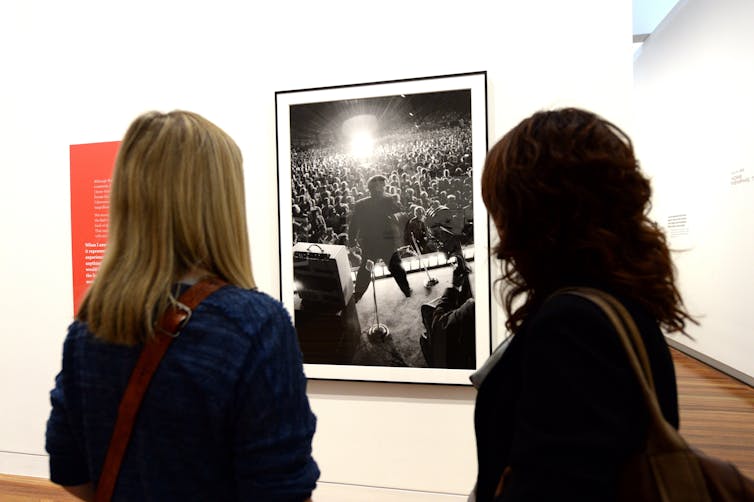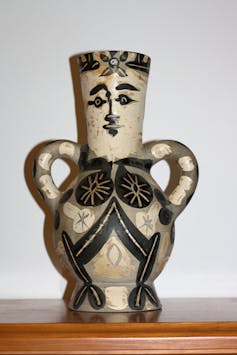An exhibit by the Australian fashion company Perks and Mini (PAM) on display at the National Gallery of Victoria (NGV) as part of its Melbourne Now exhibition has been accused of expropriating and exploiting African culture.
The display features large cardboard cutouts of a white woman dressed in an African style costume. She is posed as if she is performing the steps of a complicated native dance.
A video made by a group calling itself “art:broken” accuses PAM of ripping off themes from other cultures without regard for context or history.
PAM, described by the director of London’s Tate Modern as “one of the strongest fashion designers in the world right now” is known for its playful use of designs and motifs from African, Asian and indigenous cultures.
The critics of PAM are voicing complaints often made against artists, musicians and fashion designers who use styles, patterns and themes from the cultures of indigenous or non-Western communities.
Some critics accuse these artists and designers of theft. In their submissions to a report commissioned by the Aborigine and Torres Strait Islander Commission (1990–2005) Aborigines complained about the appropriation and marketing of their cultural heritage.
Some supporters of Aboriginal rights think that intellectual property laws should be extended to include ownership of designs, music and legends and other folklore intrinsic to the cultural identity of Aboriginal communities.
Other complaints about appropriation centre on the commercial rewards that white or Western artists and designers reap from the cultures of others. Black musicians in the segregated American South got no recognition for their musical heritage. White boy Elvis Presley was able to make their style of music into a commercial success.
The critics of PAM are particularly incensed by its lack of connection to the cultures from which it draws its material. The implication of this critique is that works based on this material must be inauthentic.
Criticisms of cultural appropriation run up against widely held beliefs about artistic creativity and freedom of artistic expression.
Westerners value artistic creativity and think that it should not be impaired by religious and political restrictions or cultural boundaries. We think that artists should be free to make use of whatever inspires their creativity.
Good artists copy, said Picasso, great artists steal. He made use of African motifs in his paintings. Monet and many other Western artists were inspired by Japanese and Chinese art.
Borrowing does not go in only one direction. Bessie Liddle, Kantjupayi Benson and many other Aboriginal artists in the NGV’s collection of indigenous art make use of Western artistic styles or materials. Black musicians were inspired by Elvis’s style of performance.

There is nothing wrong with getting inspiration and ideas from other cultures and traditions. Artistic borrowing enriches cultures. It encourages people to appreciate the culture of others. It challenges traditional ways of doing things.
The proposal to extend property laws to include symbols and themes assumes that cultures are identified by their traditions and are undermined by appropriation. It ignores the benefits of appropriation. It ignores the ability of cultures and heritage to adapt and change.
Borrowing from other cultures is not itself a moral wrong. But that doesn’t mean the critics of cultural appropriation have nothing to complain about.
Works of art and design in Western societies are commodities bought and sold in a world marketplace. Indigenous and non-Western artists and communities are often at a disadvantage. Their heritage can be exploited by those who are well placed to make gains.
It is not surprising that critics regard cultural appropriation as part of a long history of exploitation and expropriation.

Artists and designers are not responsible for this history. They cannot be blamed for taking advantage of commercial opportunities. But the fact they gain from it gives them a moral debt to those individuals or communities who contribute to their success.
They ought to give credit to those individuals and communities who were their source of inspiration.
Elvis Presley was careful to acknowledge the debt he owed to black musicians.
Those who benefit should also make a contribution to the cultural communities that inspired their works. They should consider how they can encourage or add to opportunities of their members for cultural expression.
Another problem identified by critics of appropriation results from a conflict of values. Not all cultures value free artistic expression. In some cultures artistic activity is bound up with religious rituals or ideas about the sacred. It is not difficult to understand how borrowing cultural symbols and patterns can be offensive and disrespectful.
Artists and designers have a responsibility to appreciate the meaning of what they are borrowing and to ask permission when they are in danger of giving offence.
Are the designs of PAM morally offensive? Its critics accuse it of an irresponsible and thoughtless use of cultural motifs. But there is an edge to some its works that belies this criticism. The poses of the woman in its NGV exhibit are studied and awkward, inviting us to recognise that she is playing with a cultural identity that does not belong to her.
The work is about cultural appropriation. It encourages reflection on the very issues raised by its critics.
Melbourne Now is on display at the National Gallery of Victoria until March 23. More details here.

